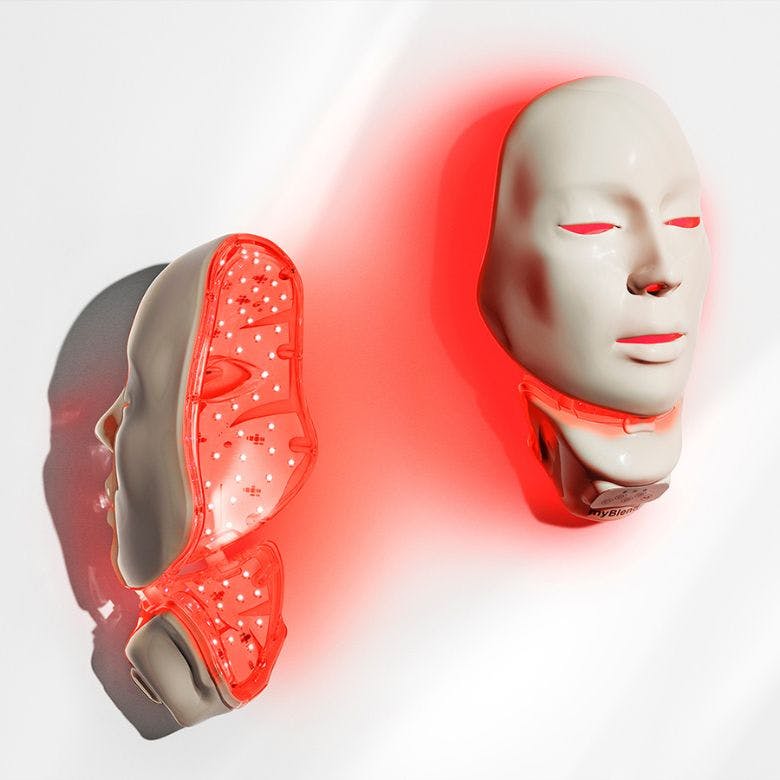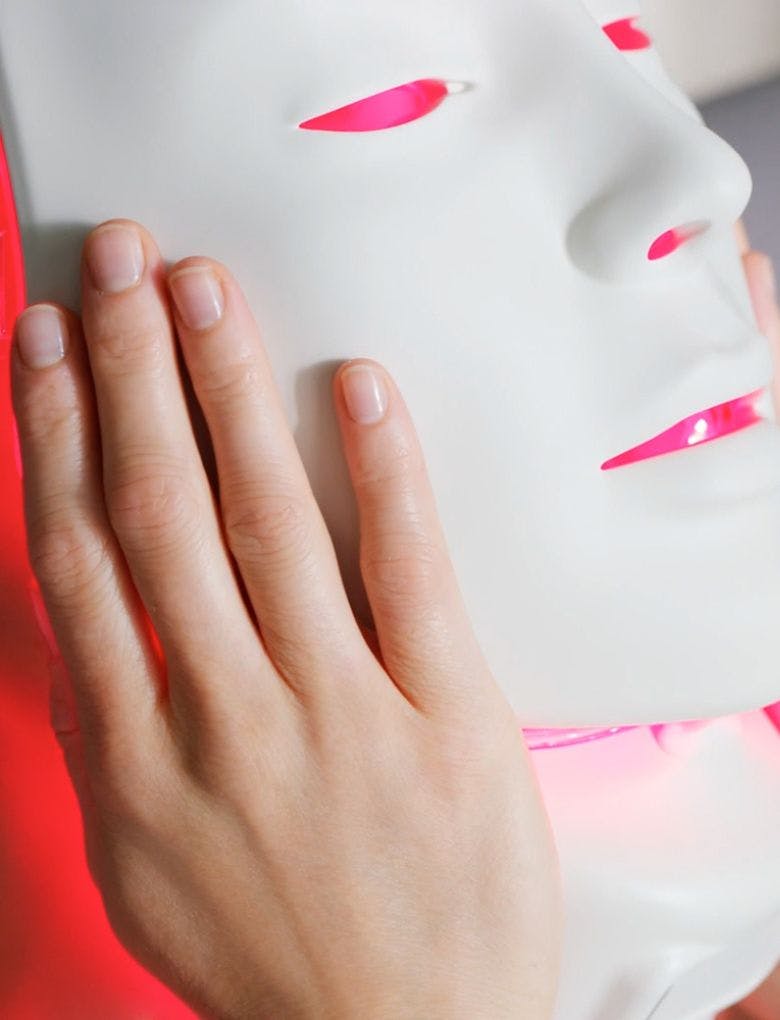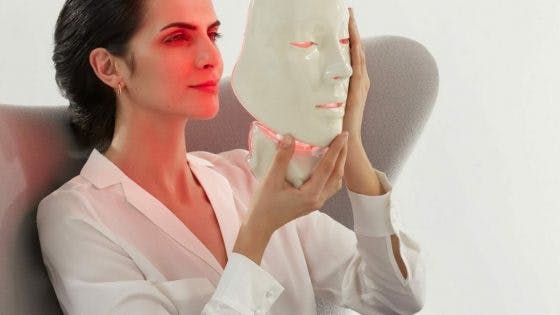LED Face Masks: All Hype Or Skin Hero?
11 minutes read
The LED face mask is a true beauty phenomenon. It’s Instafamous and went TikTok viral, as everyone from the Kardashians to Victoria Beckham has treated us to lovingly illuminated selfies sporting their latest LED masks for the face.
But do led face masks work, and is the hype around these smart devices justified? As with everything tech-related, it’s all about doing your due diligence. With the right led face mask, a light therapy device used regularly for your needs can offer a brighter and more refined complexion. It also helps you to relax, and with no downtime – what’s there not to love?
So let’s unpack what you need to know.
What are LED masks?
These masks come in many textures and shapes, but most look like a hybrid of Star Wars Stormtrooper and the Phantom. As the name light-emitting diode suggests, LEDs emit light when energy passes through them.
They have a number of LED lights (on the surface closest to the skin), and they have adjustable programmes to achieve different therapeutic results on different skin tones.
From professional use…
While not quite rocket science, NASA first used LEDs clinically in the 1990s to help heal wounds and reduce inflammation in the skin of their astronauts.
Since NASA, they’ve been used professionally as non-invasive light therapy by dermatologists, aesthetic doctors and skincare professionals.
Intense Pulsed Light (IPL) is a popular example. It has a gentler action than a laser, with little to no discomfort, and can be used instead of a laser for specific treatments.
LED therapy treats an impressive list of skin issues, including fine lines and wrinkles, skin repair and healing, inflammation and acne. And a big plus is that it’s suitable for all skin types, including sensitive and all skin tones.

… to your home
More recently, home-use LED face masks have nudged their way to pride of place on our bathroom shelves.
But how do they fit in? Think of this smart tech as an extra step, Jason Roberts, Clarins Retail Trainer, says, “Don’t think of LED masks as a replacement for your regular beauty routine, but rather as an enhancer that can elevate your current routine. It can be used as a beauty booster or to give targeted treatments. Use it as and when you need it for different purposes.”
Professional and home-use LED treatments: what’s the difference?
In-office procedures are longer and use more powerful LEDs under professional supervision, and can be customised more individually for specific skin concerns.
Of course, LED masks designed for home use aren’t (and shouldn’t be) as powerful as professional versions, so they are easy and safe for us to use at home. However, it may take longer to see visible results because they are less potent than the treatments you’d get at a dermatologist’s office.
A big upside of going DIY comes from the cumulative nature of the light-therapy treatment — you need to spend regular time continuously for several weeks under the lights to reap the benefits. At home, this is much easier to achieve and less expensive in the long run with your LED face mask. Of course, you should see a glow the moment you remove the mask, but more substantial skin improvements may take four to six weeks if you use the mask regularly, as instructed. So don’t let it gather dust on that shelf.
How do LED face masks work?
LED therapy works by using photobiomodulation.1 Instead of heat (as is used in certain lasers and radio frequency treatments, it uses light wavelengths in the visible spectrum (red, blue, yellow, amber, green, etc.) as well as invisible light (such as infrared) to penetrate different layers of the skin.
Roberts explains, “Based on the light emitted, it will penetrate to different depths of the skin, where it kickstarts different skin functions.”
Some devices use single colours, while others offer multiple colours.
LED face mask benefits
Depending on the light wavelength used, LED face masks are shown to help address the signs of premature ageing, such as stimulating collagen and elastin production, softening wrinkles, fading dark spots and evening the skin tone. They are also excellent for reducing acne and excess oil production and soothing redness, and even tackles rosacea and inflammation.
LED face mask colours: What do they mean?
Think of a colour prism or rainbow. The colours you see are the different wavelengths of visible light. For example, red has the longest wavelength and sits at one end, and blue (the shortest) at the other. Longer wavelengths penetrate deeper, so red goes deepest, and blue works in the uppermost layers of the skin. The other colours fall in between and work on glow or texture. Experts agree that the main light they have been using and the benefits of red light therapy are that they are not only fantastic for your skin – but the relaxation factor means it creeps into your wellness protocols too.
Read: Best face mask for your skin situation
Visible light
Red light is plumping and calming. It’s the most popular colour in home LED face masks as it has multiple benefits. It boosts blood circulation and stimulates the production of collagen and elastin, which helps reduce wrinkles and fine lines. It also reduces redness and inflammation, so it’s great for sensitive skin and rosacea. Find out more in The Beam Team: Red Light Therapy & What It Can Do For You.
Amber or yellow light boosts radiance and reduces swelling. However, it’s not commonly used in home-use devices.
Green light is used for thread veins (broken capillaries) and can help fade hyperpigmentation and even skin tone.
Blue light treats acne, congestion and breakouts. The other most popular LED therapy helps kill bacteria that cause acne and reduces sebaceous (oil) gland activity, producing less pore-clogging oil.
Some LED devices include red and blue light, which work together to reduce acne and soothe inflammation.
Invisible light
Near-infrared light boosts collagen and elastin. Sitting right next to red visible light, near-infrared is invisible to the naked eye, but we feel it as heat. And it penetrates deeper than all the other colours. As a result, it helps soften signs of ageing, stimulates the natural production of collagen and elastin, and speeds up recovery. You’ll find near-infrared light in the most advanced at-home LED masks.
myBlend My LED Mask, Facial & Neck Mask, £995

The myBlend myLED facial & neck mask uses red light for collagen stimulation and pulsed near-infrared light to act on cell oxygenation and boost the repair effect. myBlend says this is shown to increase treatment result efficacy: enhancing skin radiance, firmness and well-being and smoothing the skin texture. It has been proven after 1 month, the skin appears up to 3-years younger.

How to use an LED face mask
Each LED mask will have different instructions, but they should be easy to use, with preset programmes for different skin tones, which you should follow strictly.
“Always follow the guidelines from different manufacturers rigorously,” Roberts stresses, “especially when it comes to time guidance.”
When to use an LED face mask in a skincare routine
“You should always use an LED mask on perfectly cleansed skin,” Roberts says, as “if it is dirty, the LED will draw impurities into the skin.” The shine from any product residue on the skin would also cause a reflection, which could prevent the light from penetrating as effectively, so better that your skin is bare.
“Once you’ve finished,” Roberts explains, “now’s the time to add powerful products like a serum.” The boost in your circulation will help to draw in the product, making it even more effective.
Your Skincare Routine Order Explained gives you handy tips to help you get the sequence right.
Are LED face masks safe?
LED lights have an “excellent safety profile”, according to a study in the Journal of Clinical and Aesthetic Dermatology.1 They generally don’t cause skin injury, heating or irritation and are safe for all skin tones. In addition, unlike UV light, which can cause skin cancer, the penetration of this light into the skin is safe.
As dermatologist, Dr. Dennis Gross also points out in an interview, home-use LED face masks are less powerful than professional devices and must undergo even more rigorous efficacy and safety testing as they are used without professional supervision. He should know, as he is the creator of the pioneering and best-selling DRx SpectraLite FaceWare Pro.
Are LED face masks safe for the eyes?
They are considered safe, with certain precautions.
Opaque safety goggles are standard with most professional devices (which use much more powerful LEDs), and some home-use LED face masks have eye protection.
Most home-use devices should be safe, thanks to the rigorous testing they undergo. However, keeping your eyes shut during the treatment is always a good idea.
LED masks are also not recommended if you have certain eye conditions or are taking medication that makes your eyes more light-sensitive, as there could be a potential risk of eye injury. Please consult a health professional, as it may be best to avoid LED face masks completely as the light could cause irritation, blurred vision or, more seriously, vision loss.
LED face mask side effects and contraindications
While uncommon, most complications arise from misusing the mask – either for too long per session or too often, so following usage instructions is essential.
Roberts explains, “Overexposure to LED light can cause photosensitivity, which can cause sun damage when your skin is exposed to UV light. And you can’t see this happening immediately, so the damage will be done when it becomes visible.”
Using blue light longer than recommended can result in hyperpigmentation, for instance. The other concern is about eye damage, as we’ve discussed.
Stop using the LED mask immediately if you feel uncomfortable skin heating or notice redness, itching, swelling or sensitivity. And consult a health professional.
Contraindications for LED face masks
As a precaution, if you have very sensitive skin, have certain medical conditions or are on medication, it’s always advisable to seek guidance from your healthcare professional before you start a new skincare regimen.
- Medical conditions: LED masks are not advised if you have epilepsy or are prone to migraines.
- Medication: If you’re taking medication that causes photosensitivity, such as certain chemotherapy drugs, antibiotics and diuretics, as well as lithium or St. John’s wort, you shouldn’t use LED light.
- Photosensitising skincare: Be cautious about using LED and vitamin-A treatments like retinol or Accutane, as these make your skin light-sensitive and can increase your risk of side effects. Check with your dermatologist before using them together.
How often can and should you use an LED face mask?
Most LED mask manufacturers advise you to use them two to three times a week but read the usage instructions carefully, as each mask is different.
With myblend’s myLED Mask, for instance, they advise you to do three to four treatments a week, 48 hours apart. They recommend doing a course of treatments for six to eight weeks, pausing for a month between each course.
How long to use an LED face mask for
Instructions will vary depending on your chosen device, so follow the device’s instructions. There may be different programmes or settings depending on the action you want and your skin tone. Most courses last between five to 15 minutes.
Can you use an LED face mask when pregnant?
This is a bit of a tricky one… LED light therapy and pregnancy and its effect on the foetus has not been studied extensively, even though it has an excellent safety record. Some experts even recommend it to treat acne and melasma pigmentation during pregnancy.
However — not because it is unsafe, but because it is better to err on the side of caution — most device manufacturers and health professionals don’t advise it for use during pregnancy.
You can always pick up where you left off once you have your bouncing baby.
Buyer beware!
Here’s where the onus is on you. Home-use LED masks are a good example of ‘you get what you pay for’. Some scamsters are even selling bog-standard coloured lights as LED therapy online.
First, determine which device best suits your skincare needs
Do your homework to ensure your chosen device comes from a reputable company with proven safety and treatment claims. It’s also good to check if it’s been verified by regulatory bodies (‘FDA-approved’, for instance)
A good-quality LED mask will mean a fair investment, but if you weigh up the cost against going for professional treatments and the number of uses you will get from it, it may very well be a great investment in your skin
Tip: Check the expected lifespan of the product. Some devices (usually less expensive) have a maximum number of uses, while others, like myblend’s myLED Mask, have an average lifespan of 8 years.
Are you ready for the light fantastic?
MEDICAL DISCLAIMER
This article is for informational purposes only. It is not, nor is it intended to be, a substitute for professional medical advice, diagnosis, or treatment and should never be relied upon for specific medical advice. To the extent that this article features the advice of physicians or medical practitioners, the views expressed are the views of the cited expert.
Read next: Face masks that provide instant relief for dry skin
Sign up for our newsletter
We will keep you in the loop for special offers, exclusive gifts and product news.

